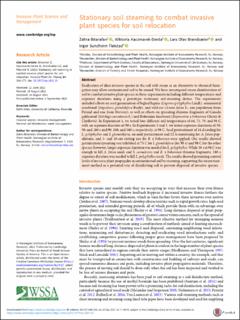| dc.contributor.author | Bitarafan, Zahra | |
| dc.contributor.author | Kaczmarek-Derda, Wiktoria Anna | |
| dc.contributor.author | Brandsæter, Lars Olav | |
| dc.contributor.author | Fløistad, Inger | |
| dc.date.accessioned | 2021-11-03T15:44:31Z | |
| dc.date.available | 2021-11-03T15:44:31Z | |
| dc.date.created | 2021-09-20T16:44:05Z | |
| dc.date.issued | 2021-09-02 | |
| dc.identifier.citation | Invasive Plant Science and Management. 2021, 14 (3), 164-171. | en_US |
| dc.identifier.issn | 1939-7291 | |
| dc.identifier.uri | https://hdl.handle.net/11250/2827689 | |
| dc.description.abstract | Eradication of alien invasive species in the soil with steam as an alternative to chemical fumigation may allow contaminated soil to be reused. We have investigated steam disinfestation of soil to combat invasive plant species in three experiments including different temperatures and exposure durations using a prototype stationary soil-steaming device. The experiments included effects on seed germination of bigleaf lupine (Lupinus polyphyllus Lindl.), ornamental jewelweed (Impatiens glandulifera Royle), and wild oat (Avena fatua L.; one population from Poland and one from Norway), as well as effects on sprouting rhizome fragments of Canada goldenrod (Solidago canadensis L.) and Bohemian knotweed (Reynoutria x bohemica Chrtek & Chrtková). In Experiment 1, we tested four different soil temperatures of 64, 75, 79, and 98 C with an exposure duration of 90 s. In Experiments 2 and 3, we tested exposure durations of 30, 90, and 180 s and 90, 180, and 540 s, respectively, at 98 C. Seed pretreatment of 14 d cooling for L. polyphyllus and I. glandulifera, no seed pretreatment and 12-h moistening for A. fatua populations, and 5- and 10-cm cutting size for R. x bohemica were applied. Our results showed germination/sprouting was inhibited at 75 C for I. glandulifera (for 90 s) and 98 C for the other species; however, longer exposure duration was needed for L. polyphyllus. While 30 s at 98 C was enough to kill A. fatua seeds and S. canadensis and R. x bohemica rhizome fragments, 180-s exposure duration was needed to kill L. polyphyllus seeds. The results showed promising control levels of invasive plant propagules in contaminated soil by steaming, supporting the steam treatment method as a potential way of disinfecting soil to prevent dispersal of invasive species. | en_US |
| dc.language.iso | eng | en_US |
| dc.publisher | Cambridge University Press | en_US |
| dc.rights | Navngivelse 4.0 Internasjonal | * |
| dc.rights.uri | http://creativecommons.org/licenses/by/4.0/deed.no | * |
| dc.title | Stationary Soil Steaming to Combat Invasive Plant Species for Soil Relocation | en_US |
| dc.type | Peer reviewed | en_US |
| dc.type | Journal article | en_US |
| dc.description.version | publishedVersion | en_US |
| dc.rights.holder | © Norwegian Institute of Bioeconomy Research, 2021 | en_US |
| dc.source.pagenumber | 164-171 | en_US |
| dc.source.volume | 14 | en_US |
| dc.source.journal | Invasive Plant Science and Management | en_US |
| dc.source.issue | 3 | en_US |
| dc.identifier.doi | 10.1017/inp.2021.25 | |
| dc.identifier.cristin | 1936259 | |
| dc.relation.project | Norges forskningsråd: 194051 | en_US |
| cristin.ispublished | true | |
| cristin.fulltext | original | |
| cristin.qualitycode | 1 | |

